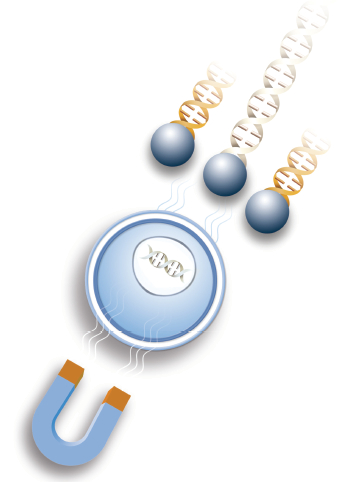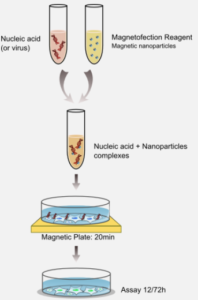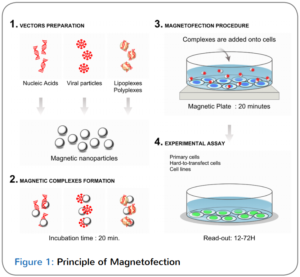 Contents
Contents
- The Principle
- How Does It Work?
- Biodistribution Of Magnetic Nanoparticles
- What Are The Applications?
- How Do I Use Magnetofection™ Reagents?
- Do I Need Specific Equipment?
Magnetofection™ is a simple and highly effective transfection method to transfect primary and hard-to-transfect cells, manufactured by Oz Biosciences and distributed in the UK by Caltag Medsystems.
Inspired by the validated and recognised magnetic drug targeting technology, this original method is a revolution for transfection and infection. In essence, with this technology, Oz Biosciences aimed to unite the advantages of the popular biochemical (cationic lipids or polymers) and physical (electroporation, gene gun) transfection methods in one system while excluding their inconveniences (low efficiency, toxicity, difficulty to handle). It is a unique technology suitable for viral and non-viral gene delivery applications.
The Principle

The principle behind Magnetofection™ is to associate nucleic acids, transfection reagents or viruses with specific magnetic nanoparticles. The resulting molecular complexes are then concentrated and transported into cells with the support of an appropriate magnetic field. In this way, the magnetic force exerted upon gene vectors allows a very rapid concentration of the entire applied vector dose on cells, so that 100% of the cells get in contact with a significant vector dose, promoting cellular uptake.
How Does It Work?
The magnetic nanoparticles are made of iron oxide, which is fully biodegradable, and coated with specific cationic molecules that vary upon application. Their association with the gene vectors (DNA, siRNA, ODN, virus, etc.) is achieved by salt-induced colloidal aggregation and electrostatic interaction. The magnetic particles are then concentrated onto cells by the influence of an external magnetic field generated by a specific magnetic plate. The cellular uptake of the genetic material is accomplished by endocytosis and pinocytosis, two natural biological processes. Consequently, membrane architecture & structure stay intact, in contrast to other physical transfection methods that damage, create holes, or electroshock the cell membranes. The nucleic acids are then released into the cytoplasm by three different mechanisms depending upon the formulation used:
- Nucleic acid delivery can occur due to the “Proton Sponge Effect” caused by the cationic polymers that coat the nanoparticles. This effect promotes endosome osmotic swelling followed by disruption of the endosomal membrane which results in the intracellular release of DNA.
- The destabilisation of the endosome can also be caused by the flip-flop of negatively charged lipids located in the endosome’s cytoplasmic-facing monolayer. These negatively charged lipids diffuse into the complex formed between the nucleic acids and the cationic lipids, neutralising the charge of the latter and promoting the release of the nucleic acid.
- Delivery of the nucleic acids can also occur by the usual viral mechanism when a virus is used.
Biodistribution Of Magnetic Nanoparticles
The biodegradable cationic magnetic nanoparticles are not toxic at the recommended doses and even higher. Gene vectors / magnetic nanoparticle complexes are internalised into cells after 10-15 minutes i.e., much faster than any other transfection method. After 24, 48 or 72 hours, most of the particles are localised in the cytoplasm in vacuoles and occasionally in the nucleus. In addition, magnetic nanoparticles do not influence cell function.
What Are The Applications?
Magnetofection™ is the only versatile and universal technology adapted to all types of nucleic acids (DNA, siRNA, dsRNA, shRNA, mRNA, ODN…), non-viral transfection systems (transfection reagents) and viruses. It has been successfully tested on a broad range of cell lines, hard-to-transfect and primary cells. It is perfect for non-dividing or slowly dividing cells, meaning that the genetic materials can go to the nucleus without cell division. OZ Biosciences has shown that combining magnetic nanoparticles with gene vectors of any kind results in a dramatic increase in the uptake of these vectors and high transfection efficiency. It is the only technology suitable for both viruses and non-viral nucleic acid delivery applications.
- For non-viral nucleic acid delivery, it is perfect for primary and hard-to-transfect adherent cells.
- For viral applications, it is ideal for any cells including primary cells (adherent and suspension).
How Do I Use Magnetofection™ Reagents?
The protocol is a very straightforward and easy procedure (Fig. 1):
- Dilute nucleic acids or vectors in serum-free medium or buffer and add a Magnetofection™ reagent.
- Incubate this for 20-30 minutes.
- Add these magnetic complexes directly onto cells and place the cell culture dish onto a magnetic plate to apply the magnetic field.
- Incubate for 5-20 minutes, remove the magnetic plate and culture the cells until experimental assay.

Do I Need Specific Equipment?
The only requirement for Magnetofection™ is a magnetic plate specifically designed for this application. The magnetic plate is a one-time buy and completely reusable, so you do not need expensive equipment, contrary to approaches such as electroporation or gene gun. The magnetic field required is produced by specific magnets. Three magnetic plates are available: Super Magnetic Plate, Magnetic Plate with 96 individual magnets and Mega Magnetic Plate. Their design allows the production of a heterogeneous magnetic field that magnetises the nanoparticles in solution, forms a very strong gradient to attract the nanoparticles and covers the whole surface of the plate. The plate can be washed with ethanol 70% and used within incubators or robots.
Originally posted by OZ Biosciences on: https://ozbiosciences.com/content/9-magnetofection-technology
Caltag Medsystems is the distributor of OZ Biosciences products in the UK and Ireland. If you have any questions about these products, please contact us.
